| Srl | Item |
| 1 |
ID:
106480


|
|
|
| 2 |
ID:
099492
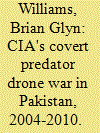

|
|
|
|
|
| Publication |
2010.
|
| Summary/Abstract |
This article provides the first overview of the CIA's secret drone campaign against Al Qaeda and the Taliban in Pakistan's tribal areas from its origins in 2001's Operation Enduring Freedom to the end of 2010. In the process it addresses the spatial dimensions of the campaign (where are the strikes being directed and where do the drones fly from), Pakistani reactions to this threat to both their sovereignty and an internal Taliban enemy, technological developments and Taliban and Al Qaeda responses to this unprecedented airborne assassination campaign. While the debate on this issue has often been driven by the extremes which either support the campaign as the most effective tool in killing terrorists or condemn it for driving Pakistanis to new levels of anti-Americanism, this article points out a third path. Namely, that many Pakistani Pashtun tribesmen living in the targeted areas support the strikes against the Taliban who have terrorized them in recent years.
|
|
|
|
|
|
|
|
|
|
|
|
|
|
|
|
| 3 |
ID:
120340
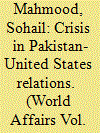

|
|
|
| 4 |
ID:
186860
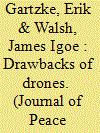

|
|
|
|
|
| Summary/Abstract |
Growing reliance on Unmanned Aerial Vehicles (UAVs) in the effort to combat militant groups has led to considerable debate about the consequences of this new mode of warfare. While critics have focused on the impact of civilian casualties on militant recruitment and the resulting use of terrorism, evidence suggests that ‘drones’ are paradoxically more effective in limiting civilian deaths compared to other forms of military force. This article demonstrates a different causal pathway connecting militant use of force to terrorist attacks. Drone strikes encourage militants to displace operations to urban centers. Confronted with unfamiliar terrain and greater government capacity, militants emphasize terrorist attacks against civilians. The article explores these dynamics in the longest running drone campaign, in Pakistan. While civilian casualties from drone strikes have no discernible effect on terrorism, strikes that kill militants increase terrorist attacks against civilians in urban settings, while failing to reduce attacks on government targets.
|
|
|
|
|
|
|
|
|
|
|
|
|
|
|
|
| 5 |
ID:
136750
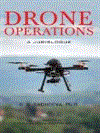

|
|
|
|
|
| Publication |
New Delhi, KW Publishers Pvt Ltd, 2015.
|
| Description |
xiv, 202p.Hbk
|
| Standard Number |
9789383649440
|
|
|
|
|
|
|
|
|
|
|
|
Copies: C:2/I:0,R:0,Q:0
Circulation
| Accession# | Call# | Current Location | Status | Policy | Location |
| 058123 | 623.7469/SAC 058123 | Main | On Shelf | General | |
| 058188 | 623.7469/SAC 058188 | Main | On Shelf | General | |
|
|
|
|
| 6 |
ID:
131248


|
|
|
|
|
| Publication |
2014.
|
| Summary/Abstract |
Recent scholarship in critical security studies argues that matter matters because it is not an inert backdrop to social life but lively, affectively laden, active in the constitution of subjects, and capable of enabling and constraining security practices and processes. This article seeks to further the debate about materiality and security. Its main claim is that materials-oriented approaches to security typically focus on the place of materials and objects within technologies and assemblages of governance. Less often do they ask how materials and objects become entangled in political controversies, and how objects mediate issues of public concern. To bring publics and contentious politics more fully into the debate about the matter of security, the article engages with Latour's work on politics, publics and things - or dingpolitik. It then connects the theme of dingpolitik to a particular controversy: Human Rights Watch's investigation of Gaza civilians allegedly killed by Israeli drone-launched missiles in 2008-2009. Drawing three lessons from this case, the article explores how further conversation between dingpolitik and security studies can be mutually beneficial for both literatures.
|
|
|
|
|
|
|
|
|
|
|
|
|
|
|
|
| 7 |
ID:
178190
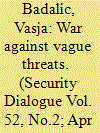

|
|
|
|
|
| Summary/Abstract |
This article explores how the United States (US) has redefined the concept of ‘imminent threat’ in order to relax the rules for anticipatory use of armed force against insurgents. The article focuses on how two new definitions of imminent threat have changed the conduct of specific combat activities, namely, drone strikes and ground combat operations.
The central part of the article is divided into four sections. The first section examines the redefinition of imminent threat in the context of drone warfare, while the second section provides an analysis of the redefinition of imminent threat in ground combat operations. Both sections show how the new definitions of imminent threat abandoned two key elements of the classic definition, that is, the immediacy and certainty of the threat. The third and fourth sections of the article explore how the new definitions of imminent threat prevented the application of two key principles governing the use of armed force: the principles of necessity and proportionality. Both sections show how successive US administrations enabled the US military to conduct operations without observing these two key principles regulating the use of force.
|
|
|
|
|
|
|
|
|
|
|
|
|
|
|
|
| 8 |
ID:
172571
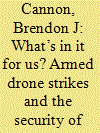

|
|
|
|
|
| Summary/Abstract |
Strikes conducted by the US using armed unmanned aerial vehicles (UAVs) against the terrorist group al-Shabaab have received widespread attention documenting the number of strikes, the reactions of the local Somalis, and the disparity between AFRICOM and local reporting. Using interview data from individuals in Mogadishu, Nairobi and elsewhere in the region, this article provides a counterpoint to previous studies by measuring the Federal Government of Somalia’s (FGS) reliance on the US drone campaign in Somalia in order to maintain its tenuous hold on power. It measures the extent to which the drone campaigns of external parties are able to insulate weak host governments from the threat of an internal foe. It finds that US drone strikes offer the occasional but only reliable check on al-Shabaab thereby allowing the FGS to continue functioning in Mogadishu. Yet strikes should not be construed as a sign of overt US support for the FGS. Rather, the US government, deeply suspicious of a highly corrupt and incapable FGS, continues to prosecute drone strikes against al-Shabaab because Washington considers the group poses a national security threat to the US.
|
|
|
|
|
|
|
|
|
|
|
|
|
|
|
|
| 9 |
ID:
120800
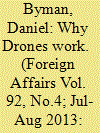

|
|
|
|
|
| Publication |
2013.
|
| Summary/Abstract |
The Obama administration relies on drones for one simple reason: they work. Drone strikes have devastated al Qaeda at little financial cost, at no risk to U.S. forces, and with fewer civilian casualties than many alternative methods would have caused.
|
|
|
|
|
|
|
|
|
|
|
|
|
|
|
|